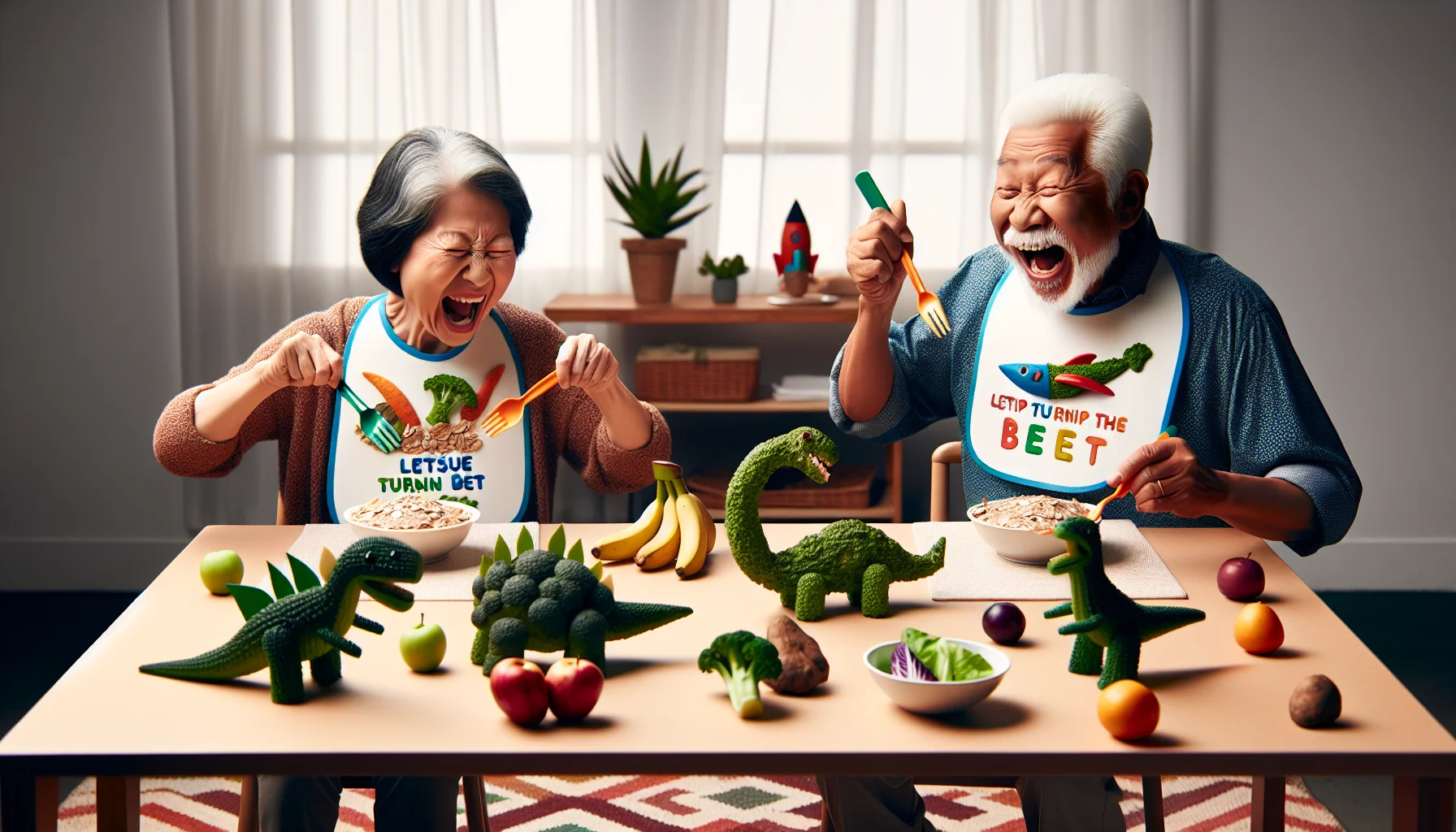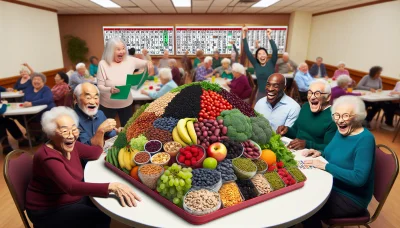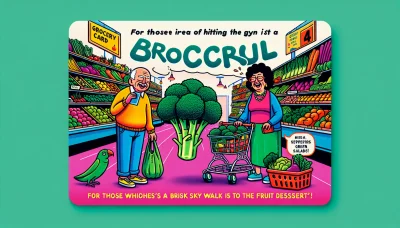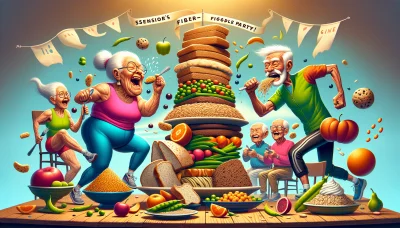High fiber toddler foods Quiz
Test Your Knowledge
Question of
Understanding High Fiber Needs for Toddlers
Importance of Fiber in Toddler Diets
Fiber is a superstar in the world of toddler nutrition! It's essential for keeping the digestive system running smoothly and can help prevent constipation, which is common in toddlers. Plus, foods high in fiber tend to be nutrient-dense, offering a plethora of vitamins and minerals alongside that all-important roughage.
But wait, there's more! Fiber isn't just about digestion. It also plays a role in keeping your little one feeling full longer, which can help with maintaining a healthy weight. Foods like fruits, vegetables, whole grains, and legumes are fiber-rich champions that should feature prominently in your toddler's meals!
Nutritional Benefits of Fiber
Get ready to be amazed by the nutritional powerhouse that is fiber! It's not just about bowel health; fiber also helps reduce the risk of heart disease and type 2 diabetes later in life. And guess what? It also aids in the absorption of essential nutrients that support your toddler's growth and development.
But hold onfiber has yet another trick up its sleeve. It acts like a broom for your toddler's digestive tract, sweeping away toxins and keeping things clean and healthy. That means a happier tummy and a happier child!
Recommended Daily Fiber Intake for Toddlers
So how much fiber should your tiny tot be getting? The American Academy of Pediatrics recommends that children aged 1-3 should aim for about 19 grams of fiber per day. This might sound like a lot, but it's totally doable with a well-planned diet packed with fruits, veggies, and whole grains!
Remember, every child is unique! Their fiber needs might differ based on their size, activity level, and overall health. Always keep an open line with your pediatrician to make sure your toddler is on track with their fiber intake.
Identifying Signs of Low Fiber Intake
Common Symptoms in Toddlers
- *Constipation: Fewer than usual bowel movements or stools that are hard to pass. *Abdominal pain: Discomfort or bloating in the belly area. *Low energy: Fiber helps regulate blood sugar levels, so low intake can lead to energy dips. *Poor appetite: A lack of fiber can throw off hunger cues and lead to disinterest in eating.
When to Consult a Pediatrician
If you're seeing signs that your toddler might not be getting enough fiber, its critical to act swiftly! Persistent constipation or dramatic changes in bowel habits warrant a chat with your pediatrician. They can rule out any underlying issues and guide you towards dietary adjustments.
Digestive woes aren't something to ignore. If your little one is showing discomfort or distress related to their gut health, it's time to seek professional advice. Your pediatrician will be your ally in ensuring your child's diet supports their overall well-being.
Balancing Fiber with Other Nutrients
Creating a Well-Rounded Toddler Diet
Balancing the fiber act is key! While fiber is crucial, its important not to overlook other vital nutrients like protein, fats, and carbohydrates. They all play starring roles in keeping your toddler energetic and growing properly.
Your mission? Craft meals that are diverse and balancedthink colorful plates filled with various food groups. This ensures that while fiber takes the nutritional stage, other nutrients aren't left waiting in the wings.
Avoiding Excessive Fiber
Buckle up because too much fiber can actually backfire! Overdoing it might lead to tummy troubles like gas or bloating and could interfere with the absorption of key minerals such as iron and calcium. Moderation is key!
The goal is harmonya diet where fiber-rich foods coexist peacefully with other nutrients without overshadowing them. Keep an eye on portion sizes and spread out high-fiber foods throughout the day to avoid overwhelming your toddler's digestive system.
Top High Fiber Foods for Toddlers
Fruits Rich in Fiber
Little ones need a lot of fiber to keep their digestive systems running smoothly, and fruits are a fantastic way to get it. Apples, pears, and berries are not only high in fiber but also packed with vitamins. These fruits can be easily incorporated into your toddler's diet and are usually a hit thanks to their natural sweetness.
Bananas are another fiber powerhouse that toddlers love. They're easy to digest and perfect for on-the-go snacks. Plus, bananas can be a versatile ingredient in many toddler-friendly recipes, from smoothies to pancakes.
Serving Ideas for Apples and Pears
When it comes to apples and pears, variety is key! Try offering them as slices with a touch of cinnamon or baked into chips for a crunchy treat. You can also stew these fruits for a warm and comforting snack that's both sweet and fibrous.
Don't forget about pear or apple sauce; it's an excellent fiber-rich alternative to other condiments or spreads that might be low in nutritional value. Use it on toast or mix it into yogurt for an extra fiber boost.
Incorporating Berries into Snacks
Berries are superstars when it comes to fiber content. Mix them into yogurt or oatmeal, or serve them as fresh finger food. For an innovative twist, try making berry-based smoothies or frozen popsiclesthey're sure to be a hit!
Blend various berries together for a colorful and fibrous addition to any meal or snack time. This not only introduces your toddler to new flavors but also packs in the nutrition.
Vegetables That Boost Fiber Intake
Vegetables are another essential source of fiber. Broccoli, carrots, and leafy greens top the list of fiber-rich veggies that can contribute significantly to your toddler's diet. Introducing these early on can help establish healthy eating habits.
Peas are also an excellent choice; they're small enough for little hands and have a sweet flavor that appeals to young palates. Plus, they can be added to just about any dishfrom rice to soupfor an instant fiber upgrade.
Kid-Friendly Ways to Serve Broccoli and Carrots
- *Make broccoli more appealing by roasting it with a drizzle of olive oil and a sprinkle of cheese. *Serve carrot sticks with hummus or yogurt dip as a fun snack. *Incorporate finely chopped vegetables into patties or meatballs where they can go unnoticed but still provide the benefits. *Create colorful veggie skewers as part of a hands-on eating experience.
Sneaking Greens into Meals
Greens like spinach and kale can be challenging for some toddlers, but don't give up! Try blending them into sauces or smoothies where their taste is masked by other ingredients. It's an easy way to sneak in that extra nutrition without a fuss.
Whole Grains for Everyday Meals
Whole grains should be a staple in your toddler's diet due to their high fiber content. Options like whole grain cereals, breads, quinoa, and oats offer essential nutrients beyond just fiber that support overall health.
Experimenting with different grains keeps meals interesting for toddlers. Barley, brown rice, and even popcorn (unsalted and unsweetened) can add variety while boosting fiber intake.
Choosing Whole Grain Cereals and Breads
When selecting cereals and breads, always check the label for whole grain ingredients. Products that list whole grains at the beginning of their ingredients tend to have higher fiber content, which is exactly what you want!
Whole grain toast with avocado or almond butter makes for a satisfying snack thats both nutritious and filling due to its fiber content.
Fun Recipes with Quinoa and Oats
Quinoa is incredibly versatileit can be used in place of rice, added to soups, or even made into cakes that toddlers will enjoy. Its high protein content alongside fiber makes it an excellent choice for growing kids.
Oats arent just for breakfast! Incorporate them into homemade granola bars or use them as breading for chicken fingers. They provide slow-releasing energy along with valuable dietary fiber which is crucial for toddlers' health.
High Fiber Breakfast Ideas for Toddlers
Quick and Easy High Fiber Cereals
Kickstart your toddler's day with a burst of energy by choosing high fiber cereals! These cereals are not just nutritious but also incredibly satisfying. They provide the essential fiber needed to support a growing toddler's digestion and overall health.
To ensure your little one doesn't get bored, try mixing different flavors or adding fresh fruit to the bowl. This adds a pop of color and a dose of natural sweetness that toddlers can't resist!
Making Cereal More Exciting
Transforming a simple bowl of cereal into an exciting breakfast is super easy! Add a sprinkle of cinnamon or a drizzle of honey for a new twist. You can even make it a fun activity by letting your toddler choose their toppings.
Understanding Cereal Labels for Fiber Content
When shopping for cereals, it's crucial to understand the labels. Look for cereals with at least 3 grams of fiber per serving. Avoid those with added sugars or artificial colors they're not what your little one needs!
Delicious Oatmeal Variations
Oatmeal is an amazing breakfast option that's both versatile and fiber-rich. It's like a blank canvas waiting for you to add some creativity. From fruits to spices, the possibilities for boosting flavor and nutrition are endless!
Sweetening Oatmeal Naturally
Naturally sweeten oatmeal by incorporating ripe bananas, applesauce, or pureed dates into the mix. This not only enhances taste but also ups the fiber content without any added sugars!
Adding Nuts and Seeds for Extra Fiber
Giving oatmeal an extra fiber boost is as simple as sprinkling in some nuts and seeds. Chia seeds, flaxseeds, or chopped almonds can provide an interesting texture that toddlers will love exploring.
Creative Toast Toppings
Bid farewell to bland toast! With creative toppings, you can elevate this simple breakfast item into something spectacular. Plus, the right toppings can significantly increase the fiber content.
- Tips for Boosting Fiber on Toast:
- Start with whole-grain bread as a high-fiber base.
- Spread avocado generously for healthy fats and additional fiber.
- Add nut butter for protein and fiber-packed mornings.
- Top with sliced fruits like strawberries or bananas for extra nutrients.
- Sprinkle chia or pumpkin seeds on top for a crunchy finish.
Avocado and Nut Butter Spreads
The creamy texture of avocado spread on toast is not only appealing but also full of heart-healthy fats. Swirl in some almond or peanut butter, and you've got a toast that's both delicious and nutritious!
Fruit and Cheese Combinations
Create an irresistible combo by topping toast with thin slices of cheese and fruit like pears or apples. This pairing offers a delightful balance of savory and sweet while packing in the fiber!
High Fiber Lunches and Dinners for Toddlers
Protein and Fiber-Packed Lunch Ideas
Creating a balanced lunch for your toddler doesn't have to be a chore! Focus on incorporating lean proteins and high-fiber foods to keep them full and energized. Think beyond the traditional lunchboxquinoa with diced chicken, or a turkey and avocado roll-up can be both tasty and nutritious.
Legumes are a fantastic way to pack in protein and fiber. A simple chickpea salad, lightly seasoned, is easy for little hands to eat. Or consider black bean mini-burgersa hit for their size and flavor! Pair these with whole-grain bread for an extra fiber boost.
Legume-Based Dishes
Dishes like lentil soup or bean-based casseroles are not only filling but also provide essential nutrients for growing toddlers. Use mild spices to make these dishes more kid-friendly. You can also blend cooked legumes into pasta sauces for a seamless addition of fiber.
High Fiber Wraps and Sandwiches
Wraps and sandwiches are convenient options that don't skimp on fiber, especially when you use whole-grain tortillas or bread. Fill them with a variety of veggies, shredded chicken, or tofu for a well-rounded meal. A spread of hummus adds flavor and an extra fiber punch!
Dinner Recipes with a Fiber Twist
Tonight's dinner can be both delicious and fiber-rich! By incorporating vegetables into classic meals, your toddler won't even notice they're eating something healthy. A spaghetti squash in place of traditional pasta is a fun and fibrous alternative they'll love twirling onto their forks.
Integrating Vegetables into Classic Meals
Pizza night? Top it with an array of colorful veggies for added fiber. Or try sneaking grated zucchini into meatballsthe kids will be none the wiser! These small tweaks to familiar dishes can significantly increase the nutritional value of your toddler's dinner.
Using Whole Grains as a Base
A switch to whole grains is a simple yet effective strategy for upping fiber intake. Brown rice stir-fry with mixed vegetables offers an excellent platform for creativityadd different proteins or sauces to keep things interesting. Barley or farro can also serve as tasty alternatives to white rice.
- Mix it up: Use various whole grains throughout the week to provide diversity in taste and nutrients.
- Sneak in the veggies: Add finely chopped or pureed vegetables into sauces, stews, and bakes.
- Creative presentation: Make food visually appealing by creating fun shapes or faces with healthy ingredients.
- Gentle seasoning: Use mild herbs and spices to enhance flavor without overwhelming young palates.
- Bite-sized portions: Cut foods into small, manageable pieces for easier eating.
- Kid-approved recipes: Involve your toddler in choosing recipes or helping with preparation to pique their interest in high-fiber meals.
- Frequent rotation: Regularly introduce new fiber-rich foods alongside familiar favorites to expand your child's tastes.
- Patient persistence: It may take several attempts before your toddler accepts new textures or flavors, so keep trying!
Snacks and Sides That Complement Main Dishes
The right snacks can not only tide your toddler over until mealtime but also contribute significantly to their daily fiber intake. Veggie sticks are perfect for munching and when paired with a hummus dip, they become an irresistible snack loaded with nutrients.
Veggie Sticks and Hummus Dip
This classic combination is not only healthy but also fun for toddlers to eat. The creamy texture of hummus makes it appealing, while the crunch of veggie sticks provides satisfying feedback. It's an easy way to introduce raw vegetables into your childs diet.
Fruit and Cheese Pairings
Fruit paired with cheese offers a sweet and savory experience that most toddlers love. Apples or pears provide dietary fiber while cheese adds protein and calciumessential components for growth. This snack is quick to prepare and perfect for on-the-go days!
Managing a High Fiber Diet for Picky Eaters
Introducing New Foods Gradually
When it comes to picky eaters, patience is key. Start by incorporating small amounts of new, fiber-rich foods into meals your child already enjoys. This gradual introduction helps the child become familiar with new textures and flavors without overwhelming them. Consistency and variety are vitaloffer the new food multiple times in various forms to increase acceptance.
Understand that it's normal for children to be cautious about new foods. Avoid making a big fuss when presenting these items. Instead, serve them alongside their favorites, and let curiosity take its course. If they don't bite initially, don't give uptaste buds evolve!
The Division of Responsibility in Feeding
Embrace the division of responsibility approach: parents decide what foods to offer and when, while children decide if they'll eat it and how much. This method allows children to listen to their hunger cues without pressure, making mealtime less stressful for everyone involved.
By following this approach, you respect your childs appetite and avoid power struggles at the table. Offer a balance of high fiber options alongside familiar favorites to encourage variety without coercion.
Encouraging Self-Feeding with Fiber-Rich Foods
Self-feeding is more than just a milestone; it's an opportunity to build a positive relationship with food. Provide fiber-rich foods that are easy to handle like soft-cooked vegetables, ripe fruits, and whole-grain finger foods. This encourages autonomy and makes mealtime engaging.
Monitor your child as they explore different textures and tastes on their own terms. The act of choosing what and how much to eat empowers them and can lead to more adventurous eating habits over time.
Making Fiber Fun: Creative Presentation Ideas
Let's face it, presentation can make or break a child's interest in food. Use cookie cutters to create fun shapes out of whole-grain bread or pancakes. Incorporate colorful fruits and veggies into mealsarrange them into patterns or faces on the plate for visual appeal.
- Tip 1: Make "food art" together with your childthis not only makes fiber-rich foods more appealing but also turns meal prep into a bonding activity.
- Tip 2: Use dips! Children love dipping their food. Offer hummus, yogurt, or homemade salsas as tasty companions for veggies.
- Tip 3: Always include at least one food your child likes on the plate to ensure they have something familiar alongside the new options.
- Mistake to Avoid: Don't mask the taste of all high-fiber foods; allow your child to appreciate their natural flavors too.
Using Shapes and Colors to Entice Toddlers
Toddlers are visually stimulated which means the more vibrant and playful the meal appears, the better! Mix bright vegetables like bell peppers or carrots with neutral-toned high-fiber grains like brown rice or quinoa for a colorful contrast that catches their eye.
High Fiber Snack Solutions for Toddlers on the Go
Portable Snack Ideas Packed with Fiber
When you're juggling the demands of a busy schedule, portable snacks can be life-saving. Opt for fiber-rich snacks that keep your toddler full and focused. Foods like apple slices or carrot sticks not only pack a punch of fiber but also provide essential vitamins and minerals. Portability is key, so consider how well the snack travels and if it can be easily consumed on the move.
Homemade Granola Bars and Muffins are terrific options to include in your toddler's snack rotation. These can be loaded with oats, nuts, and dried fruits, all of which are excellent sources of fiber. The beauty of homemade snacks is control over ingredients, ensuring your bars are low in sugar and high in nutritional value.
Fresh Fruit and Veggie Bags are another fantastic choice. You can mix different colorful vegetables like bell peppers or cucumbers with fruits like berries or pear slices for a variety-filled snack. These bags are not only high in fiber but also hydrate and energize your little one throughout the day.
Buying Smart: High Fiber Packaged Snacks
Sometimes convenience is king, and packaged snacks can come to the rescue. However, it's crucial to choose wisely to ensure they're beneficial for your child. Look for snacks that have whole grains as their primary ingredient and are free from artificial additives.
When it comes to Reading Nutrition Labels for Fiber Content , aim for snacks that offer at least 3-5 grams of fiber per serving. Be wary of added sugarssnacks with high fiber content can sometimes compensate with additional sweeteners.
- Avoid snacks that list sugar as one of the first three ingredients.
- Choose snacks with "whole grain" as the first ingredient.
- Be cautious of "fiber fortified" products that add synthetic fiber.
- Opt for organic options when possible to reduce exposure to pesticides.
- Remember that natural fiber from fruits, vegetables, and whole grains is always preferable.
Hydration and Fiber: The Perfect Pair
It's essential to pair high fiber snacks with adequate hydration. Fiber absorbs water as it moves through the digestive system, which helps maintain regular bowel movements. Insufficient water intake can lead to constipation, especially in toddlers who have increased their fiber intake.
There are many Flavorful Ways to Encourage Drinking Water . Infuse your child's water with slices of fruit like strawberries or oranges for a hint of flavor without added sugars. This not only makes drinking water more appealing but also adds some extra nutrients into their diet.
Navigating Challenges with High Fiber Diets in Toddlers
Dealing with Digestive Adjustments to Increased Fiber
Introducing a high fiber diet to toddlers can lead to significant digestive changes. While fiber is excellent for bowel regularity, an abrupt increase may cause discomfort. It's essential to introduce fiber-rich foods gradually, allowing the toddler's digestive system time to adapt.
Gas, bloating, and changes in stool consistency are common as toddlers adjust to more fiber. These symptoms should ease over time; however, persistent issues might signal that the dietary change is too rapid or not suitable for your child.
Recognizing Normal Changes vs. Concerns
It's vital to differentiate between typical adjustments and potential red flags. Normal changes include increased frequency of bowel movements and alterations in stool appearance. On the other hand, severe abdominal pain or constipation may indicate that the fiber intake needs reassessment.
Monitoring your toddler's reactions closely will help you fine-tune their fiber intake. If you notice any alarming signs or if discomfort persists, consult a pediatrician for guidance on how to proceed safely.
Tips for Easing Digestive Discomfort
- Increase water intake alongside fiber-rich foods to help ease digestion.
- Incorporate fiber gradually into meals rather than all at once.
- Combine high-fiber foods with familiar favorites to make them more palatable.
- Offer smaller, more frequent meals throughout the day instead of large portions.
- Avoid highly processed foods that can exacerbate digestive issues.
- Maintain a food diary to track which foods may be causing discomfort.
- Encourage physical activity as it can aid in regular bowel movements.
Ensuring Adequate Caloric Intake Alongside Fiber
Fiber-rich foods can be less calorie-dense, which poses a challenge for ensuring toddlers receive enough energy. Strike a balance by including both high-fiber and calorie-dense foods within their diet.
Regularly monitor your toddlers growth patterns and energy levels. If there are signs of slowed growth or decreased activity, it might be time to adjust their diet to ensure they're getting enough calories for their developmental needs.
Balancing High Fiber Foods with Calorie-Dense Options
To maintain an appropriate caloric intake, integrate healthy fats and proteins with fibrous foods. Avocado, full-fat dairy products, nuts (if safe), and lean meats are excellent options that provide necessary calories and nutrients.
Mixing high-calorie foods into fiber-rich dishes can also help maintain caloric needs without compromising on the benefits of fiber. For example, adding cheese to a vegetable dish or serving nut butter with fruit are both palatable and nutritious combinations.
Monitoring Growth and Energy Levels in Toddlers
Growth and energy levels serve as indicators of nutritional adequacy. Regular check-ups with a healthcare provider will ensure your toddler's growth is on track while following a high-fiber diet.
If a toddler appears lethargic or less active than usual, it could signal inadequate caloric intake. In such cases, re-evaluating their diet with a nutritionist or pediatrician becomes crucial for their health and well-being.
Educating Caregivers on Your Toddler's Dietary Needs
Caregivers play a pivotal role in maintaining your toddler's dietary regimen. Providing them with clear instructions and education about your childs dietary needs is imperative for consistency in nutrition.
Create simple guidelines or meal plans for caregivers to follow. This helps avoid confusion and ensures your toddler receives the right balance of nutrients even when you're not around.
Communicating with Daycare and Babysitters
Open communication with daycare providers or babysitters is essential for dietary adherence. Discuss your childs dietary requirements in detail, emphasizing the importance of following them strictly for your child's health benefits.
By sharing successful strategies that work at home with caregivers, youre creating an environment where your toddlers dietary needs are understood and met consistently across different care settings.
Preparing Meals and Snacks for Others to Serve
To simplify the process for other caregivers, consider preparing meals and snacks in advance. This not only ensures that dietary requirements are met but also relieves stress for those caring for your child.
Pack easy-to-serve options like pre-cut vegetables with dip or whole-grain crackers paired with cheese slicesfoods that are both nutrient-dense and appealing to toddlers taste buds!












